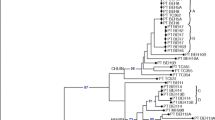Abstract
Forty-seven samples of date palm (Phoenix dactylifera L.) collected from eight locations in Egypt were studied using four sets of amplified fragment length polymorphism (AFLP) markers with near infrared fluorescence labeled primers. These samples belonged to 21 named accessions and 9 of unknown pedigrees. A total of 350 bands were scored and 233 (66.6%) were polymorphic. Twenty-seven Egyptian accessions and ‘Medjool’and ‘Deglet Noor’accessions from California could beclassified into the major cluster. This major cluster may represent a major group of date palm germplasm in North Africa. There were four other clusters, each containing one or two accessions. The variety ‘Halawy’and one accession of unknown provenance were most likely from hybridization between two clusters. Six groups of accessions of which had the same names, revealed similar but not identical AFLP profiles suggesting these accessions might derive from seedlings rather thanthrough clonal offshoot propagation.
Similar content being viewed by others
Abbreviations
- AFLPs:
-
amplified fragment length polymorphism
- UPGMA:
-
unweighted pair group method of the arithmetic average
- PCA:
-
principal coordinated analysis
- PCR:
-
polymerase chain reaction
References
A.A.M. Al-Jibouri K.M. Adham (1990) ArticleTitleBiochemical classification of date palm male cultivars J. Hort. Sci 65 725–729
M. Azeqour K. Majourhat M. Baaziz (2002) ArticleTitleMorphological variations and isoenzyme polymorphism of date palm clones from in vitro culture acclimatized and established on soil in South Morocco Euphytica 123 57–66 Occurrence Handle10.1023/A:1014441324726
M. Baaziz M. Saaidi (1988) ArticleTitlePreliminary identification of date palm cultivars by esterase isoenzymes and peroxidse activities Can. J. Bot. 66 89–93
S. Barrow (1998) ArticleTitleA monograph of Phoenix L. (Palmae: Coryphoideae) Kew Bull. 53 513–575
K. Bendiab M. Baaziz K. Majourhat (1998) ArticleTitlePreliminary date palm cultivar composition of Moroccan palm groves as revealed by leaf isozyme phenotypes Biochem. Syst. Ecol. 26 71–82 Occurrence Handle10.1016/S0305-1978(97)00078-1
M. Bennaceur C. Lanaud M.H. Chevallier N. Bounaga (1991) ArticleTitleGenetic diversity of the date palm (Phoenix dactylifera L.) from Algeria revealed by enzyme markers Plant Breeding 107 56–69
T.W. Brown (1924) ArticleTitleDate palm in Egypt Ministry Agri. EgyptTech. Sci. Service Bull. 43 39
T.W. Brown M. Bahgat (1938) ArticleTitleDate-palm in Egypt Ministry Agri. EgyptTech. Sci. Service Booklet 24 117
B.R. Cao C.T. Chao (2002) ArticleTitleIdentification of date (Phoenix dactylifera) cultivars in California using AFLP markers HortScience 37 966–968
deRecherchePhoenicicole de Dégache. 2002. Sauvegarder la diversité génétique du palmier dattier à lȁ9oasis de Dégache (Tunisie). Problèmes et perspectives. International Centre for development oriented Research in Agriculture (ICRA) working document No. 107, pp. 89.
B. Corniquel L. Mercier (1994) ArticleTitleDate palm (Phoenix dactylifera L.) cultivar identification by RFLP and RAPD Plant Sci. 101 163–172 Occurrence Handle10.1016/0168-9452(94)90252-6
B. Corniquel L. Mercier (1997) ArticleTitleIdentification of date palm (Phoenix dactylifera L.) cultivars by RFLP: partial characterization of a cDNA probe that contains a sequence encoding a zinc finger motif Int. J. Plant Sci. 158 152–156 Occurrence Handle10.1086/297425
P.S. Devanand C.T. Chao (2003) ArticleTitleGenetic variation within ‘Medjool’and ‘Deglet Noor’date (Phoenix dactylifera L.) cultivars in California detected by fluorescent-AFLP markers J. Hort. Sci. Biotech. 78 405–409
I. El Hadrami R. Cheikh M. Baaziz (1995) ArticleTitleSomatic embryogenesis and plant regeneration from shoot-tip explants in Phoenix dactylifera L Biol. Plant. 37 205–211
El-Kharbotly A., El-Mardi M., Al-Saadi N. and Al-Mahruki Y. 1998. Towards the construction of a genetic map of date palms using the amplified fragment length polymorphism technique (AFLP). In: Proceedings of the First International Conference on Date Palms, Al-Ain, United Arab Emirates, pp. 194–207
Letouze R., Daguin F., Satour P., Hamama L. and Marionnet F. 1998. Molecular characterization of Egyptian date palm: II. RAPD fingerprints. In: Proceedings of the First International Conference on Date Palms, Al-Ain, United Arab Emirates, pp. 158–167
Mason S.C. 1927. Date culture in Egypt and the Sudan. USDA Bulletin No. 1457, Washington, DC, USApp. 72.
Mokhtar T., AbdelAli B., Abdelmajid R., Andre´ R. and Mohamed M. 1998. Molecular characterization of Tunisian date palm cultivars. In: Proceedings of the First International Conference on Date Palms, Al-Ain, United Arab Emirates, pp. 183–193.
Myburg A.A., O’Malley D., Sederoff R.R. and Whetten R. 2000. High-throughput multiplexed AFLP analysis of interspecific hybrids of Eucalyptus trees species. In: Plant and Animal Genome VIII Conference, San Diego, USA, pp. 544
Nixon R.W. 1950. Imported cultivars of dates in the United States. USDA Circular No. 834, Washington, DC, USApp. 144.
F.J. Rohlf (2000) NTSYSpc, Numerical Taxonomy and Multivariate Analysis SystemVersion 2.1 User Guide Exeter Software SetauketNew York, USA
Saker M.M. and Moursy H.A. 1998. Molecular characterization of Egyptian date palm: II. RAPD fingerprints. In: Proceedings The First International Conference on Date Palms. Al-Ain, United Arab Emirates, pp. 173–182
A.O.M. Salem M. Trifi H. Sakka A. Rhouma M. Marrakchi (2001) ArticleTitleGenetic inheritance analysis of four enzymes in date palm (Phoenix dactylifera L.) Genet. Resour. Crop Evol. 48 361–368 Occurrence Handle10.1023/A:1012097900950
M.H. Sedra P. Lashermes P. Trouslot M. Combes S. Hamon (1998) ArticleTitleIdentification and genetic diversity analysis of date palm (Phoenix dactylifera L.) cultivars from Morocco using RAPD markers Euphytica 103 75–82 Occurrence Handle10.1023/A:1018377827903
D.R. Sharma S. Dawra J.B. Chowdhury (1984) ArticleTitleSomatic embryogenesis and plant regeneration in date palm (Phoenix dactylifera Linn.) cv. ‘Khadravi’through tissue culture Indian J. Exp. Biol. 22 596–598
P.H.A. Sneath R.R. Sokal (1973) Numerical Taxonomy: The Principles and Practice of Numerical Classification W.H. Freeman and company San Francisco, USA 359
S.S. Soliman B.A. Ali M.M.M. Ahmed (2003) ArticleTitleGenetic comparisons of Egyptian date palm cultivars (Phoenix dactylifera L.) by RAPD-PCR African J. Biotech. 2 86–87
A.M. Torres B. Tisserat (1980) ArticleTitleLeaf isozyme as genetic markers in date palms Am. J. Bot. 67 162–167
Author information
Authors and Affiliations
Corresponding author
Rights and permissions
About this article
Cite this article
El-Assar, A.M., Krueger, R.R., Devanand, P.S. et al. Genetic Analysis of Egyptian Date (Phoenix dactylifera L.) Accessions Using AFLP Markers. Genet Resour Crop Evol 52, 601–607 (2005). https://doi.org/10.1007/s10722-004-0583-z
Received:
Accepted:
Issue Date:
DOI: https://doi.org/10.1007/s10722-004-0583-z




